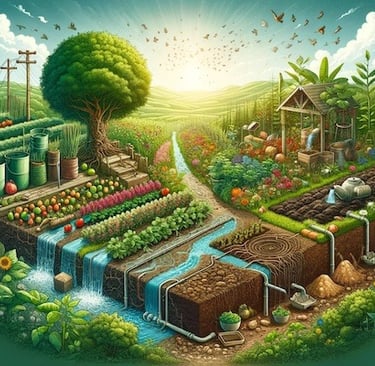
Challenges and Solutions of Using Permaculture for Sustainability
Bruce Gibson ND
5 min read


Permaculture is a sustainable design system that aims to mimic the patterns and relationships found in natural ecosystems.
It is based on the principles of ecology, conservation, and whole-systems thinking and seeks to create sustainable human settlements and agricultural systems that are harmonious with the natural world.
Permaculture is not just about agriculture, but also encompasses the design of human settlements and lifestyles. It emphasizes the use of renewable resources, the minimization of waste, and the creation of systems that are self-sustaining and resilient. Permaculture practices can be applied to gardens, farms, and even entire communities.
One of the key principles of permaculture is the notion of "care for the earth." This means recognizing the interconnectedness of all living things and the need to protect and restore the natural environment. Permaculture aims to create systems that are sustainable and regenerative, rather than extractive and destructive.
Another key principle of permaculture is "care for people." This means ensuring that the systems we create meet the needs of all people, both present and future. Permaculture seeks to provide for the basic needs of food, shelter, and energy in ways that are equitable and accessible to all. It also emphasizes the importance of building strong, resilient communities and fostering a sense of connection and interdependence among people.
Permaculture also incorporates the principle of "fair share," which means taking only what is needed and returning the surplus to the earth and to the community. This means reducing waste and overconsumption, and instead focusing on meeting our needs in ways that are sustainable and regenerative.
One of the key practices of permaculture is the use of polycultures, or the planting of multiple species of plants together in a single area. This mimics the diversity found in natural ecosystems and can help to promote biodiversity, increase resilience, and improve the overall health of the system. Polycultures can also help to conserve water and reduce the need for chemical fertilizers and pesticides.
Another important permaculture practice is the use of food forests, or agroforestry systems that mimic the structure and function of natural forests. In a food forest, a diverse array of edible and useful plants are grown together in a way that mimics the relationships and interactions found in a natural forest ecosystem. This can provide a wide range of food and other resources, while also supporting biodiversity and improving the health of the soil.
Permaculture also emphasizes the importance of working with, rather than against, natural processes. This means using techniques such as composting, mulching, and natural pest control to create healthy, fertile soil and to support the growth of plants. It also means considering the entire ecosystem when making decisions, rather than just looking at individual parts in isolation.
One of the benefits of permaculture is that it can help to increase food security. By using sustainable practices, permaculture systems can produce a consistent and reliable source of food, even in challenging environments. Permaculture gardens and farms can also provide a wide range of fruits, vegetables, nuts, and other foods, which can help to diversify the diet and provide essential nutrients.
Permaculture can also help to improve the health of the soil, which is vital for the growth of healthy plants. Permaculture practices such as composting, mulching, and the use of cover crops can help to build soil organic matter and improve soil structure, which can in turn increase water retention and improve nutrient cycling. This can lead to healthier plants, which are better able to resist pests and diseases.
Another benefit of permaculture is that it can help to conserve natural resources, such as water and energy. By using techniques such as rainwater harvesting and the establishment of windbreaks and other microclimates, permaculture systems can minimize the need for external inputs and maximize the use of natural resources. This can help to reduce the environmental impact of agriculture and make it more sustainable in the long term.
Permaculture can also help to support biodiversity. By using polycultures and food forests, permaculture systems can provide habitat for a wide range of plants and animals, which can help to promote biodiversity and maintain the health of the ecosystem. This can have a positive impact on the overall health and resilience of the system.
Additionally, permaculture can foster a sense of community and connection among people. By bringing people together to work on common goals and to share knowledge and skills, permaculture can help to build strong, resilient communities that are better able to withstand challenges and to adapt to change. It can also provide a sense of purpose and fulfillment for those involved, as they work together to create systems that are sustainable and regenerative.
One of the challenges of permaculture is that it can require a significant investment of time and effort to establish and maintain. Creating a permaculture system from scratch can take years, as the soil must be built up and the plants must be carefully selected and nurtured. Additionally, permaculture systems can require ongoing care and attention, as they are complex and dynamic.
Another challenge of permaculture is that it can require a significant change in mindset and lifestyle. Permaculture practices can be unfamiliar and counterintuitive to those who are accustomed to more conventional forms of agriculture, and can require a willingness to learn and to experiment. This can be a barrier for some people, who may be unwilling or unable to make the necessary changes.
Despite these challenges, permaculture offers many benefits and has the potential to transform the way we think about agriculture and sustainability. By mimicking the patterns and relationships found in natural ecosystems, permaculture can help to create sustainable, resilient systems that provide for the needs of people and the planet. It offers a holistic approach to sustainability that takes into account the interconnectedness of all living things and the importance of protecting and restoring the natural world.
Additionally, permaculture can provide a sense of connection and purpose for those involved, as they work together to create systems that are sustainable and regenerative. Permaculture can also be a source of innovation and creativity, as practitioners are encouraged to experiment and to find new ways of meeting their needs in sustainable ways.
One of the key ways that permaculture can be implemented is through the creation of community-based projects. These can range from small-scale permaculture gardens and farms, to larger-scale initiatives such as sustainable housing developments and urban agriculture projects. By involving the local community in the planning and implementation of these projects, permaculture can help to build strong, resilient communities that are better able to withstand challenges and to adapt to change.
Another way that permaculture can be implemented is through education and outreach. By sharing knowledge and skills about permaculture practices, individuals and organizations can help to raise awareness and to inspire others to adopt more sustainable ways of living. This can include everything from workshops and classes, to online resources and networking opportunities.
In conclusion, permaculture offers a holistic approach to sustainability that takes into account the interconnectedness of all living things and the importance of protecting and restoring the natural world. By using sustainable practices and working with natural processes, permaculture can help to create resilient, self-sustaining systems that provide for the needs of people and the planet. It can also foster a sense of community and connection among people, and provide a source of innovation and creativity. While it can require a significant investment of time and effort, the benefits of permaculture are numerous and have the potential to transform the way we think about agriculture and sustainability.
Whether on a small scale in our own backyards, or on a larger scale within our communities, permaculture offers a sustainable and resilient path forward for us all.
Let's talk about it...
Challenges and Solutions of Using Permaculture for Sustainability

